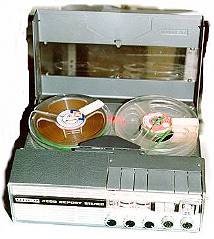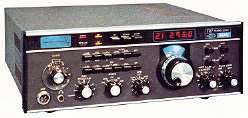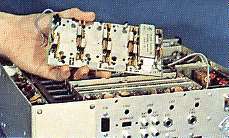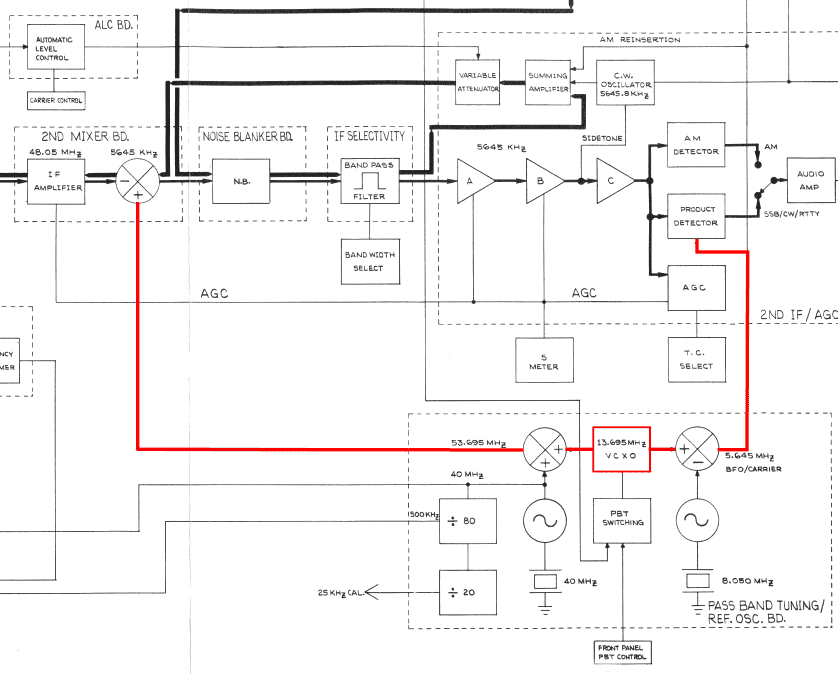Background
In common with many other developing countries, Botswana has internal communications difficulties. Roads are long, and frequently poor in the rural areas away from the railway line. The internal telephone and telecommunications network is hardly developed at all; "telephone quality" is at best adequate, at worst unusable for rebroadcasting.It is hardly surprising, therefore, that a frequent criticism of the national radio station has been its lack of "Botswana news". A recent report (1) quoted a resident of Serowe as asking "Why don't you just call it Radio Gaborone, because that's what it is?" Clearly, the station had to place high priority on the rapid passing of news from the Districts to the capital.

A Uher tape recorder from the late 1970s
The Technical Problem
What was needed was an alternative to the public telephone network which was fast, reliable and capable of sustaining reasonable quality. Cost and ease of operation were also very important.The obvious solution was the use of radio. Unfortunately, the distances involved precluded VHF for all but the most local Information Offices. HF, on the other hand, is subject to all sorts of interference, and if SSB is used, usually of poor quality and limited bandwidth unless highly sophisticated equipment is available. The choice of frequency can be critical throughout the day to optimise signal-to-noise ratio, and this implies a certain amount of frequency agility in a remote installation, which can cause considerable problems with aerials or tuning units. Not least among the technical obstacles is the provision of power for radio transceiver equipment.
All these disadvantages usually restrict the use of HF SSB radio to basic communication. Commercial SSB equipment is normally fairly reliable, but powering, aerials and above all audio quality frequently reduce its usefulness for broadcast purposes to a minimum.
Nevertheless, it was decided that Radio Botswana should investigate the use of HF SSB transceivers, attempting to find ways round the problems mentioned above. To a large extent, this has been successful. In the process, a low-cost aerial has been developed, and some interesting information derived relating to the tuning of SSB signals by non-technical staff.
The Transceiver
From the start, it was realised that the correct choice of SSB transceiver would be crucial to the success of the project. To this end, a loose specification was drawn up and tenders were invited from various commercial manufacturers. [The specification included: 2.0-18.5 MHz coverage; a.m. detector; 100W output; transmit bandwidth to 5 kHz; 12v operation; reception of medium wave; 6 crystal TX channels; VFO receiver; high-quality audio stages; service manuals and spares.]
The Drake TR-7 transceiver

The TR-7 IF selectivity board has space for four filters
SSB Generation
At this point, it is interesting to dwell on the method of setting the carrier frequency in the TR-7, relative to the SSB filter, and the effect this has on the quality of transmission.Most commercial transceivers generate SSB using a fixed intermediate carrier frequency (crystal controlled) which is accurately placed on the side of the selectivity curve of a fixed frequency crystal or mechanical filter. The SSB thus generated is then heterodyned to the required output frequency.
A disadvantage of this method is that, once the manufacturer has decided on the position of the "carrier" relative to the filter, there is very little the user can do to change it, short of purchasing a range of crystals around the nominal carrier frequency and plugging them in one by one until satisfied. This stems, of course, from the very reasons a crystal was chosen in the first place - ie. high frequency stability and resistance to "pulling" by external circuitry. Lest it be thought that no adjustment is necessary, it is worth pointing out that a difference in "carrier" frequency of only tens of Hertz can have a noticeable effect on transmitted quality. (NB: this refers not to accuracy of subsequent resolution of the signal at the receiver, but to how far down the slope of the filter the carrier is placed). Unfortunately, manufacturing tolerances may mean differences of a couple of hundred Hertz between optimum carrier frequencies for nominally identical SSB filters, and this has a marked effect on transmitted audio quality.
In fairness, the average communications user would probably not notice anything amiss. Certainly, there is normally no provision made for adjusting the carrier frequency in commercial transceivers; in any case, it is unlikely that conventional trimmer capacitors would be able to force excursions of two or three hundred Hertz in an otherwise well-designed crystal oscillator operating on its fundamental frequency around 2-8 MHz.
